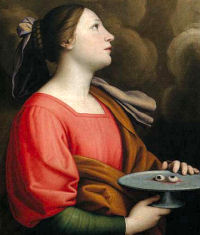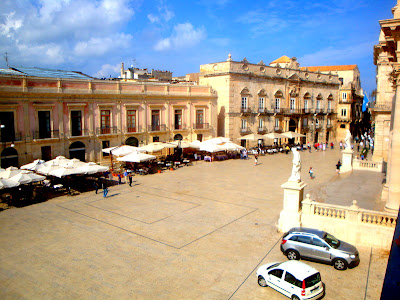Lucie, la brillante, en marche vers la lumière de Noël.
Il est très facile aujourd’hui d’harmoniser la fête du jour avec les pensées de l’Avent. Lucie (en français : la brillante) rentre dans le symbolisme de l’Avent. Au milieu des ténèbres (nous sommes au moment où les jours sont le plus courts) elle « luit » comme une vierge prudente qui va, avec sa lampe allumée, à la rencontre de l’Époux. Lucie est le modèle de l’Église et de l’âme qui doivent revêtir la parure nuptiale pour aller au-devant de l’Époux.
Sainte Lucie. — Jour de mort : 13 décembre, vers 304. Tombeau : à Venise. Image : On la représente avec une épée et deux yeux sur un plat. Sa vie : Lucie est une des plus illustres vierges martyres de l’ancienne Église. Un jour, elle se rendait avec sa mère, qui souffrait d’un épanchement de sang, à Catane pour honorer le corps de sainte Agathe. Elle pria à son tombeau.
Alors la sainte lui apparut en songe et la consola ainsi : « O vierge Lucie, pourquoi me demandes-tu ce que tu peux toi-même accorder à ta mère : ta foi aussi vient à son secours, c’est pourquoi elle est guérie. Tu as par ta virginité préparé à Dieu une demeure agréable » (Brév.). Elle obtint en effet la guérison de sa mère. Aussitôt, elle lui demanda la permission de rester vierge et de distribuer aux pauvres du Christ la dot qui devait lui revenir.
A son retour à Syracuse, elle consacra aux pauvres tout le produit de la vente de ses biens. A cette nouvelle, un jeune homme auquel ses parents avaient, contre son gré, promis sa main, la dénonça comme chrétienne au gouverneur.
« Tu parleras moins », lui dit le gouverneur, « quand une grêle de coups tombera sur toi. »
« Les serviteurs de Dieu », répondit la vierge, « ne manquent jamais des mots qui conviennent, car c’est le Saint-Esprit qui parle par notre bouche.
« Est-ce que le Saint-Esprit est en toi ? » lui demanda Paschasius. « Oui », répondit-elle, « tous ceux qui vivent avec piété et chasteté sont les temples du Saint-Esprit. » « C’est bien », reprit le gouverneur, « je te ferai conduire dans une maison de débauche pour que le Saint-Esprit s’éloigne de toi. » « Si tu me fais déshonorer malgré moi », répondit la vierge, « la couronne victorieuse de ma pureté sera doublée. »
Enflammé de colère, le juge ordonna de conduire Lucie dans cette maison, mais Dieu la rendit tellement immobile qu’aucune force ne put la déplacer. Alors on versa sur elle de la poix et de la résine ainsi que de l’huile bouillante, mais comme tout cela ne lui causait aucun mal, on lui trancha la tête avec le glaive. C’est ainsi qu’elle acheva victorieusement son martyre. – Dom Pius Parsch, le Guide dans l’année liturgique
* * * * * *
SAINT LUCY VIRGIN, MARTYR

May the glorious intercession of the Virgin and Martyr Saint Lucy give us new heart, we pray, O Lord, so that we may celebrate her heavenly birthday in this present age and so behold things eternal. Through our Lord Jesus Christ, your Son, who lives and reigns with you in the unity of the Holy Spirit, one God, for ever and ever.
The traditional story of St. Lucy tells us that she was of noble Greek parentage, born in Syracuse, Sicily, and brought up as a Christian by her mother, Eutychia. Although Lucy, like Cecilia, wished to dedicate herself to God, Eutychia arranged for her a marriage with a young pagan. The mother, who suffered from hemorrhage, was persuaded to make a pilgrimage to Catania, to offer prayers at the tomb of St. Agatha.
Lucy accompanied her mother, and their prayers for a cure were answered. Then Lucy made known to Eutychia her desire to give her own share of their fortune to the poor and devote herself to God's service. Eutychia, in gratitude for her cure, gave permission. This so angered the young man to whom Lucy had been unwillingly betrothed that he denounced her as a Christian to the governor, Paschius.
The persecutions instituted by the Emperor Diocletian were then at their height, and when Lucy steadfastly clung to her faith, she was sentenced to prostitution in a brothel. God rendered her immovable and the officers were not able to carry her off to the place of evil. An attempt was then made to burn her, but boiling oil and pitch had no power to hurt her or break her strong spirit. At last she was put to death by the sword.
At Rome in the sixth century Lucy was honored among the other virgin martyrs, and her name was inserted in the Canon of the Mass. A reference to her sanctity occurs in a letter written by Pope Gregory the Great. In the Middle Ages, she was invoked by persons suffering from eye trouble, perhaps because Lucy (in Italian, Lucia) derives from , the Latin word for light. The first church writer to give an account of St. Lucy from her was the English bishop St. Aldhelm of Sherborne at the end of the seventh century.
This saint's relics are venerated at Venice and at Bourges, in France. She is patroness of Syracuse; her emblems are a cord and eyes.
* * *

May the glorious intercession of the Virgin and Martyr Saint Lucy give us new heart, we pray, O Lord, so that we may celebrate her heavenly birthday in this present age and so behold things eternal. Through our Lord Jesus Christ, your Son, who lives and reigns with you in the unity of the Holy Spirit, one God, for ever and ever.
* * * * * *
RECALLING A VISIT TO SIRACUSA
During my time in Italy in October, I was able to travel for several days in Sicily, including to Siracusa, the city of the martyrdom of Santa Lucia.
Everywhere the legendary Sicilian hospitality was in evidenece: Archbishop Salvatore Pappalardo graciously showed us around his Curia and residence and a hospital chaplain gave us a tour of the cathedral built on the foundations of a pagan temple.
The church here has existed from earliest times and the cathedral is dedicated to Saints Peter and Paul, the latter having made a three-day stop-over in Syracuse en route to Rome (Acts 28.12) while the former, while in Antioch, is said to have sent the first bishop St. Marcianus to exercise apostolic leadership in the Siracusan Church.
The relics and traditions about St. Lucy are strongly emphasized in the cathedral.
Some photos:








No comments:
Post a Comment